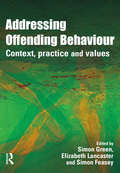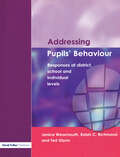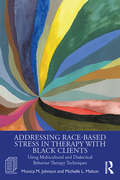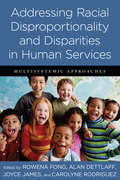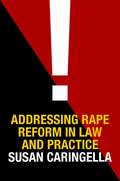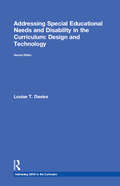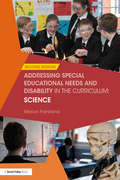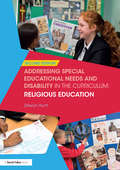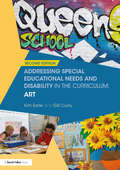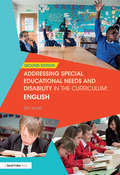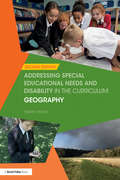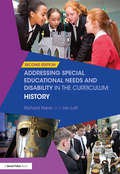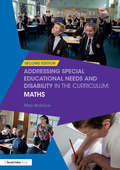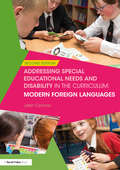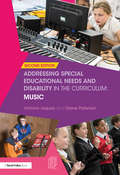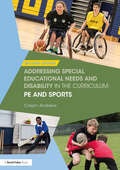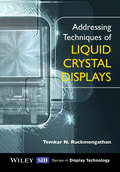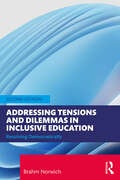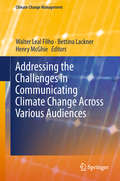- Table View
- List View
Addressing Offending Behaviour: Context, Practice and Value
by Simon Green Elizabeth Lancaster Simon FeaseyOffending behaviour is one of the most talked about issues in contemporary society. What can be done to stop people reoffending? What can be done to help people escape their criminal lifestyles? This book aims to review and analyse the different ways in which these questions are addressed in practice, drawing upon the expertise of academics and practitioners.The book provides a critical reference text for practitioners, students and researchers interested in devising the most effective means of addressing offending behaviour. Its focus is on the actual work undertaken with offenders, and draws upon generic issues of practice applicable across the voluntary, community and statutory sectors.Addressing Offending Behaviour aims to bridge the gap between practice and research. It explores a wide range of innovative techniques for offender intervention, along with some of the most challenging academic theories. It also considers the wider social, political and legal context in which this work takes place, and explores the values and bias which operate at both individual and institutional levels.It will be key reading for both students and practitioners involved in the fields of criminology and criminal justice, law, policing, probation, prisons, youth justice and social work.
Addressing Pupil's Behaviour: Responses at District, School and Individual Levels
by Janice Wearmouth Ted Glynn Robin C. RichmondThe challenges posed by the behavior of some pupils can only be properly addressed if support is extended beyond the classroom. Linking theory and practice, this book outlines a range of assessment and intervention techniques at: * District and community level * School level * Classroom level * Individual level
Addressing Race-Based Stress in Therapy with Black Clients: Using Multicultural and Dialectical Behavior Therapy Techniques
by Monica M. Johnson Michelle L. MeltonDespite Black Americans being at high risk for negative mental health symptoms due to racism and other chronic stresses, disparities persist in the provision of mental health services to this population. This book addresses that gap in clinical practice by explicitly calling attention to the experience of race-based stress in the Black community. Johnson and Melton urge mental health practitioners to action in promoting societal understanding, affirmation, and appreciation of multiculturalism against the damaging effects of individual, institutional, and societal racism, prejudice, and all forms of oppression based on stereotyping and discrimination. Chapters include worksheets, vignettes, and case studies to provide a practical framework for implementing an effective, nonpathological approach to ameliorating the damaging effects of race-based trauma and stress. This book will give tools and strategies for mental health professionals to responsibly use scientific and professional knowledge to improve the condition of individuals, communities, and, by extension, society.
Addressing Racial Disproportionality and Disparities in Human Services: Multisystemic Approaches
by Fong Rowena Dettlaff Alan James Joyce Rodriguez CarolyneThe issue of racial disproportionality in the child welfare system, particularly as it impacts African American children and families, has long been a concern to practitioners and policymakers. However, disproportionality is not limited to the African American community. Latino, Native American, Asian American, and Pacific Islander populations experience inequities in treatment. From leading voices on culturally-competent care comes a cutting-edge book that examines disproportionalities across all of these racial and ethnic groups.Eliminating Racial Disproportionality and Disparities examines a wide range of systems that often affect and interact with child welfare. Chapters are devoted to the juvenile justice system, mental health, the courts, education, and healthcare, making it the only book to offer a multisystemic approach to disparities and disproportionality. Filled with in-depth case studies, key terms, study questions, and resources, and written to reflect CSWE-mandated competencies, this expansive book gives students, educators, policymakers, practitioners, and administrators new knowledge for providing culturally competent services while simultaneously addressing disproportionality across various systems of care.
Addressing Racial Disproportionality and Disparities in Human Services: Multisystemic Approaches
by Fong Rowena Dettlaff Alan James Joyce Rodriguez CarolyneThe first book to examine disproportionality across various systems of care and multiple ethnic populations.
Addressing Rape Reform in Law and Practice
by Susan CaringellaThe first comprehensive book on rape since Susan Brownmiller's Against Our Will and Susan Estrich's Real Rape, this volume probes every aspect of rape law and the discrepancies between ideal law (on the books) and real law (in action). Susan Caringella canvasses the success and failure of reform in the United States, as well as Australia, Britain, Canada, and New Zealand, and assesses alternative perspectives on rape reform, making use of theoretical models, court cases and statistical data. She uniquely delineates a creative model for change while addressing the discretion that undermines efforts at change. This includes charging the accused and plea bargaining, confronting a lack of transparency and accountability in implementing law, and acquiring funding for such changes.
Addressing Sickle Cell Disease: A Strategic Plan And Blueprint For Action
by National Academies of Sciences, Engineering, and Medicine Health and Medicine Division Board on Population Health and Public Health Practice Committee on Addressing Sickle Cell Disease: A Strategic Plan and Blueprint for ActionSickle cell disease (SCD) is a genetic condition that affects approximately 100,000 people in the United States and millions more globally. Individuals with SCD endure the psychological and physiological toll of repetitive pain as well as side effects from the pain treatments they undergo. Some adults with SCD report reluctance to use health care services, unless as a last resort, due to the racism and discrimination they face in the health care system. Additionally, many aspects of SCD are inadequately studied, understood, and addressed. Addressing Sickle Cell Disease examines the epidemiology, health outcomes, genetic implications, and societal factors associated with SCD and sickle cell trait (SCT). This report explores the current guidelines and best practices for the care of patients with SCD and recommends priorities for programs, policies, and research. It also discusses limitations and opportunities for developing national SCD patient registries and surveillance systems, barriers in the healthcare sector associated with SCD and SCT, and the role of patient advocacy and community engagement groups.
Addressing Special Educational Needs and Disability in the Curriculum: Design And Technology (Addressing SEND in the Curriculum)
by Louise T. DaviesThe SEND Code of Practice (2015) reinforced the requirement that all teachers must meet the needs of all learners. This topical book provides practical, tried-and-tested strategies and resources that will support teachers in making design and technology lessons accessible and interesting for all pupils, including those with special educational needs. The author draws on a wealth of experience to share her understanding of special educational needs and disabilities and show how the design and technology teacher can reduce or remove any barriers to learning. Offering strategies that are specific to the context of design and technology teaching, this book will enable teachers to: better identify a student’s particular learning requirements; set inclusive design and making assignments which allow all students to participate and succeed; build students’ confidence in using a range of materials and tools; assist with design tasks where pupils take ownership of their work and learning; adapt the classroom environment to meet the needs of pupils; create a mutually supportive classroom which maximises learning opportunities. An invaluable tool for continuing professional development, this text will be essential for design and technology teachers (and their teaching assistants) seeking to include and motivate all pupils in their lessons, regardless of their individual needs. This book will also be of interest to secondary SENCOs, senior management teams and ITT providers. In addition to free online resources, a range of appendices provide design and technology teachers with a variety of pro forma and activity sheets to support effective teaching. This is an essential tool for design and technology teachers and teaching assistants, and will help to deliver successful, inclusive lessons for all pupils.
Addressing Special Educational Needs and Disability in the Curriculum: Science (Addressing SEND in the Curriculum)
by Marion FranklandThe SEND Code of Practice (2015) reinforced the requirement that all teachers must meet the needs of all learners. This topical book provides practical, tried and tested strategies and resources that will support teachers in making science lessons accessible and exciting for all pupils, including those with special needs. The author draws on a wealth of experience to share her understanding of special educational needs and disabilities and show how science teachers can reduce or remove any barriers to learning. Offering strategies that are specific to the context of science teaching, this book will enable teachers to: help all students develop their ‘evidence-gathering’ skills and aid their scientific discovery by involving the use of all of the senses and structuring tasks appropriately; create a supportive environment that maximises learning opportunities; plan the classroom layout and display to enhance learning; use technology to adapt lessons to the needs of individual pupils; successfully train and fully use the support of their teaching assistants. An invaluable tool for continuing professional development, this text will be essential for teachers (and their teaching assistants) seeking guidance specific to teaching science to all pupils, regardless of their individual needs. This book will also be of interest to SENCOs, senior management teams and ITT providers. In addition to free online resources, a range of appendices provide science teachers with a variety of writing frames and activity sheets to support effective teaching. This is an essential tool for science teachers and teaching assistants, and will help to deliver successful, inclusive lessons for all pupils.
Addressing Special Educational Needs and Disability in the Curriculum: Second Edition (Addressing SEND in the Curriculum)
by Dilwyn HuntThe SEND Code of Practice (2015) reinforced the requirement that all teachers must meet the needs of all learners. This topical book provides practical, tried and tested strategies and resources that will support teachers in making RE lessons accessible and interesting for all pupils, including those with special needs. The author draws on a wealth of experience to share his understanding of special educational needs and disabilities and show how the RE teacher can reduce or remove any barriers to learning. Offering strategies that are specific to the context of RE teaching, this book will enable teachers to: create a supportive environment which maximises learning opportunities; plan the classroom layout and display to enhance learning; help students of all levels to gain confidence in their reading and writing ability; stimulate discussion and develop thinking skills through using stimuli such as religious art, music, artefacts and films; successfully train and fully use the support of their teaching assistants. An invaluable tool for continuing professional development, this text will be essential for teachers (and their teaching assistants) seeking guidance specific to teaching RE to all pupils, regardless of their individual needs. This book will also be of interest to SENCOs, senior management teams and ITT providers. In addition to free online resources, a range of appendices provide RE teachers with a variety of writing frames and activity sheets to support effective teaching. This is an essential tool for RE teachers and teaching assistants, and will help to deliver successful, inclusive lessons for all pupils.
Addressing Special Educational Needs and Disability in the Curriculum: Art (Addressing SEND in the Curriculum)
by Kim Earle Gill CurryThe SEND Code of Practice (2015) reinforced the requirement that all teachers must meet the needs of all learners. This topical book provides practical, tried and tested strategies and resources that will support teachers in making art lessons accessible and interesting for all pupils, including those with special needs. The authors draw on a wealth of experience to share their understanding of special educational needs and disabilities and show how the art teacher can reduce or remove any barriers to learning. Offering strategies that are specific to the context of art teaching, this book will enable teachers to: develop students’ understanding, appreciation and enjoyment of art and design; advance students’ sense of enquiry about visual and tactile experiences; help pupils to realise their creative intentions, through the development of technical competence and manipulative skills; provide opportunities for personal and imaginative enquiry; sample a variety of art and design projects to use in their own lessons; plan the classroom layout and display to enhance learning; successfully train, and fully use the support of, their teaching assistants. An invaluable tool for continuing professional development, this text will be essential for secondary art teachers (and their teaching assistants) seeking guidance specific to teaching art to all pupils, regardless of their individual needs. The book will also be of interest to secondary SENCOs, senior management teams and ITT providers. Full of practical ideas and inspiration, and supported by free online resources, this is an essential tool for art teachers and teaching assistants and will help to deliver successful, inclusive lessons for all pupils.
Addressing Special Educational Needs and Disability in the Curriculum: English (Addressing SEND in the Curriculum)
by Tim HurstThis book provides practical strategies and resources that have been proven effective in teaching English to pupils of all abilities, making English accessible, challenging and exciting. The author outlines important key principles that should underpin teaching and learning so that all pupils, including those with special educational needs, can enjoy the subject and make outstanding progress. The ideas and guidance draw on a wealth of experience, providing classroom activities and free online resources, which can be combined with different teaching approaches. A range of appendices provides teachers with real-life case studies and examples and templates for supporting pupils with SEND. Offering strategies that are specific to the context of English teaching, this book will enable teachers and their teaching assistants to: develop pupils’ understanding by engaging multi-sensory approaches; ensure all pupils are able to participate fully in lessons and achieve success; design and use individual plans for pupils with SEND; assess and adapt content and resources when differentiating materials for pupils with a wide range of learning needs; use formative assessments to measure learning and inform planning. An invaluable tool for whole-school continuing professional development, this fully revised text will be essential for teachers and their teaching assistants seeking guidance specific to teaching English to all pupils, regardless of their individual needs. This book will also be of interest to SENDCOs, learning support units and senior management teams as well as to teacher-training professionals.
Addressing Special Educational Needs and Disability in the Curriculum: Geography (Addressing SEND in the Curriculum)
by Helen HarrisThe SEND Code of Practice (2015) reinforced the requirement that all teachers must meet the needs of all learners. This topical book provides practical, tried and tested strategies and resources that will support teachers in making geography lessons accessible and interesting for all pupils, including those with special needs. The author draws on a wealth of experience to share her understanding of individual needs and show how the geography teacher can reduce or remove any barriers to learning. Offering strategies that are specific to the context of geography teaching, this book will enable teachers to: ensure all pupils are able to participate in every lesson; provide inclusive fieldwork opportunities that take into consideration the needs of all pupils; use formative assessments to measure learning and inform planning; plan the classroom layout and display to enhance learning; successfully use the support of their teaching assistants. An invaluable tool for continuing professional development, this text will be essential for middle school and secondary geography teachers (and their teaching assistants) who are committed to creating an inclusive learning environment for all pupils, regardless of their individual needs. The book will also be of interest to SENCOs and inclusion managers, curriculum co-ordinators, senior management teams and ITT providers. Full of practical ideas and inspiration, and supported by free online resources, this is an essential tool for geography teachers and teaching assistants who want to deliver successful, inclusive lessons for all pupils.
Addressing Special Educational Needs and Disability in the Curriculum: History (Addressing SEND in the Curriculum)
by Richard Harris Ian LuffThe SEND Code of Practice (2015) has reinforced the requirement that all teachers must meet the needs of all learners. This topical book provides practical, tried and tested strategies and resources that will support teachers in making history lessons accessible and exciting for all pupils, including those with special needs. The authors draw on a wealth of experience to share their understanding of special educational needs and disabilities and show how the history teacher can reduce or remove any barriers to learning. Offering strategies that are specific to the context of history teaching, this fully revised edition will enable teachers to: Make history education accessible and engaging to pupils of all abilities Create an inclusive classroom environment that responds to the emotional needs of the class and nurtures a culture of learning Develop inclusive practical demonstration and role play techniques to aid conceptual understanding Set assessment objectives Deploy in-class support effectively An invaluable tool for continuing professional development, this text will be essential for teachers (and their teaching assistants) seeking guidance specific to teaching history to all pupils, regardless of their individual needs. This book will also be of interest to SENDCOs, senior management teams and ITT providers. In addition to practical activities and supporting material contained in the book, there are also free online resources for readers to download and use in the preparation of successful, inclusive lessons for all pupils.
Addressing Special Educational Needs and Disability in the Curriculum: Maths (Addressing SEND in the Curriculum)
by Max WallaceThe SEND Code of Practice (2015) reinforced the requirement that all teachers must meet the needs of all learners. This topical book provides practical, tried and tested strategies and resources that will support teachers in making maths lessons accessible and interesting for all pupils, including those with special needs. The author draws on a wealth of experience to share his understanding of special educational needs and disabilities and show how the maths teacher can reduce or remove any barriers to learning. Offering strategies that are specific to the context of maths teaching, this book will enable teachers to: adopt a ‘problem solving’ approach to ensure students use and apply mathematics at all times during their learning develop students’ understanding of mathematical ideas structure lessons to empower and actively engage students create a mutually supportive classroom which maximises learning opportunities plan the classroom layout and display to enhance learning, for example displaying number lines, vocabulary lists and pupils’ work successfully train and fully use the support of their teaching assistants. An invaluable tool for continuing professional development, this text will be essential for secondary maths teachers (and their teaching assistants) seeking guidance specific to teaching maths to all pupils, regardless of their individual needs. This book will also be of interest to secondary SENCOs, senior management teams and ITT providers. In addition to free online resources, a range of appendices provide maths teachers with a variety of pro forma and activity sheets to support effective teaching. This is an essential tool for maths teachers and teaching assistants, and will help to deliver successful, inclusive lessons for all pupils.
Addressing Special Educational Needs and Disability in the Curriculum: Modern Foreign Languages (Addressing SEND in the Curriculum)
by John ConnorThe SEND Code of Practice has reinforced the requirement that all teachers must meet the needs of all learners. This book provides practical, tried and tested strategies and resources that will support teachers in making modern foreign languages accessible, challenging and exciting for all pupils, including those with special needs. The author draws on a wealth of experience to share his understanding of how SEND can affect learning and how the MFL teacher can reduce or remove any barriers to learning. Offering strategies that are specific to the context of MFL teaching, this book will enable teachers to: ensure all pupils are able to participate fully in every lesson; develop pupils’ understanding, motivation and enjoyment; adapt content and resources when differentiating materials for pupils with a wide range of learning needs; use formative assessments to measure learning. An invaluable tool for whole-school continuing professional development, this text will be essential for teachers (and their teaching assistants) seeking guidance specific to teaching languages to all pupils, regardless of their individual needs. This book will also be of interest to SENCOs, senior management teams and ITT providers.
Addressing Special Educational Needs and Disability in the Curriculum: Music (Addressing SEND in the Curriculum)
by Victoria Jaquiss Diane PatersonThe SEND Code of Practice (2015) has reinforced the requirement that all teachers must meet the needs of all learners. This topical book provides practical, tried and tested strategies and resources that will support teachers in making music lessons accessible and exciting for all pupils, including those with special needs. The authors draw on a wealth of experience to share their understanding of special educational needs and disabilities and show how the music teacher can reduce or remove any barriers to learning. Offering strategies that are specific to the context of music teaching, this book will enable teachers to: ensure all pupils are able to enjoy and appreciate music; find the appropriate musical instruments to suit the individual learner; develop approaches for teaching composition in mixed ability classrooms; provide opportunities for different types of performance; adapt content, approaches and resources for pupils with a wide range of learning needs. An invaluable tool for continuing professional development, this text will be essential for teachers (and their teaching assistants) seeking guidance specific to teaching music to all pupils, regardless of their individual needs. This book will also be of interest to SENCOs, senior management teams and ITT providers. In addition to free online resources, a range of appendices provides music teachers with lesson case studies, behaviour plans and guidance on behaviour management and effective teaching. This is an essential tool for music teachers and teaching assistants, and will help to deliver successful inclusive lessons for all pupils.
Addressing Special Educational Needs and Disability in the Curriculum: PE and Sports (Addressing SEND in the Curriculum)
by Crispin AndrewsThis topical book provides practical, tried and tested strategies and resources that will support teachers in making PE lessons accessible, rewarding and exciting for all pupils, including those with special needs. The author draws on a wealth of experience to share his understanding of special educational needs and disabilities and show how the PE teacher can reduce or remove any barriers to learning participation. Offering strategies that are specific to the context of PE and sports teaching, this book will enable teachers to: ensure all pupils are able to enjoy and appreciate the value of exercise and sport; create an inclusive environment; tailor activities to fit the needs of mixed ability groups; help pupils to develop the skills and confidence to enjoy different kinds of sport; encourage young people to think about what they are doing and make appropriate decisions for themselves. An invaluable tool for continuing professional development, this text will be essential for teachers, coaches and teaching assistants seeking guidance specific to teaching PE and sport to all pupils, regardless of their individual needs. This book will also be of interest to SENCOs, senior management teams and ITT providers. With free online material and practical resources in the appendices, this is an essential tool for everyone striving to engage all pupils in PE and sport.
Addressing Structural Racism, Bias, and Health Communication as Foundational Drivers of Obesity: Proceedings Of A Workshop Series
by National Academies of Sciences, Engineering, and Medicine Health and Medicine Division Food and Nutrition Board Roundtable on Obesity SolutionsThe National Academies of Sciences, Engineering, and Medicine's Roundtable on Obesity Solutions convened a three-part workshop series that explored how structural racism, weight bias and stigma, and health communication intersect with obesity, gaps in the evidence base, and challenges and opportunities for long-term, systems-wide strategies needed to reduce the incidence and prevalence of obesity. Through diverse examples across different levels and sectors of society, the workshops explored how to leverage the connections between these three drivers and innovative data-driven and policy approaches to inform actionable priorities for individuals, organizations, and policymakers to make lasting systems change.
Addressing Techniques of Liquid Crystal Displays
by Temkar N. RuckmongathanUnique reference source that can be used from the beginning to end of a design project to aid choosing an appropriate LCD addressing technique for a given application This book will be aimed at design engineers who are likely to embed LCD drivers and controllers in many systems including systems on chip. Such designers face the challenge of making the right choice of an addressing technique that will serve them with best performance at minimal cost and complexity. Readers will be able to learn about various methods available for driving matrix LCDs and the comparisons at the end of each chapter will aid readers to make an informed design choice. The book will address the various driving techniques related to LCDs. Due to the non-linear response of the liquid crystal to external voltages, different driving methods such as passive and active matrix driving can be utilized. The associated theoretical basis of these driving techniques is introduced, and this theoretical analysis is supplemented by information on the implementation of drivers and controllers to link the theory to practice. Written by an experienced research scientist with over 30 years in R&D in this field. Acts as an exhaustive review and comparison of techniques developed for passive-matrix addressing of twisted nematic and super-twisted nematic (STN) LCDs. Discusses the trend towards "High Definition" displays and that a hybrid approach to drive matrix LCDs (combination of active and passive matrix addressing) will be the future of LCD addressing. Contains the author's recent work on Bit-Slice Addressing that is useful for fast responding LCDs, as well as a chapter on driving ferroelectric LCDs Provides an objective comparison that will enable designers to make an informed choice of an addressing technique for a specific application. Includes examples of the practical applications of addressing techniques. Organised in a way that each chapter can be read independently; with the basic knowledge and historical background gained from the introductory chapters, adequate for understanding the techniques that are presented in the remaining chapters making it a self-contained reference.
Addressing Tensions and Dilemmas in Inclusive Education: Living with uncertainty
by Brahm NorwichBased on extensive research, Addressing Tensions and Dilemmas in Inclusive Education presents a contemporary and critical analysis of the interaction between different perspectives and positions in the field of inclusive education. Referring to existing attitudes on the education of children and young people with learning difficulties and disabilities, Professor Norwich argues that despite the appeal of inclusion as a single powerful position, its practical realisation involves tensions and dilemmas that have to be addressed and resolved. This core analysis is illustrated by a review of relevant national and international concepts, principles, research and practices drawing on literature in areas of current interest and concern, such as: identification and classification; current national and international conceptions; pedagogic and curriculum issues; organisation of schooling; parental and student perspectives; the contribution of research to policy and practice. Engaging with the fundamental issues in the field and providing a coherent perspective that recognises and justifies the inter-connection between specialised and general school provision, this accessible and timely book will be of interest to all researchers and students of inclusive education.
Addressing Tensions and Dilemmas in Inclusive Education: Resolving Democratically
by Brahm NorwichThis updated second edition of Addressing Tensions and Dilemmas in Inclusive Education further develops the critical analysis of the initial edition that integrates the interaction between different perspectives and positions in the field of inclusive education. This key resource expands the arguments present in the first edition with clearer implications about how to address tensions and dilemmas in inclusive education, and resolve them through democratic deliberation. Based on contemporary research, theory and policy, as well as responding to current perspectives towards the education of children and young people with learning difficulties and disabilities, Brahm Norwich extends and refines the original core argument of the previous edition – the practical realisation of inclusion involves tensions and dilemmas that have to be addressed and resolved. This core analysis focuses on:- identification and classification- current national and international conceptions- pedagogic and curriculum issues- organisation of schooling- parental and student perspectives and the contribution of research to policy and practice.Re-engaging with the fundamental issues in the field and providing a coherent perspective that recognises and justifies the inter-connection between specialised and general school provision, this accessible new edition will be of interest to all students and researchers of inclusive education.
Addressing the Adverse Consequences of Cancer Treatment: Proceedings Of A Workshop
by National Academies of Sciences, Engineering, and Medicine Health and Medicine Division Board on Health Care Services Forum on Aging, Disability, and Independence National Cancer Policy Forum Sharyl Nass Margie Patlak Francis AmankwahCancer treatment can lead to an array of significant short- and long-term physical, psychosocial, and socioeconomic consequences for patients and their families. To examine the opportunities to prevent and mitigate the adverse effects of cancer treatment, the National Academies of Sciences, Engineering, and Medicine hosted a virtual workshop, Addressing the Adverse Consequences of Cancer Treatment, in November 2020. This workshop was convened by the Academies' National Cancer Policy Forum in collaboration with the Forum on Aging, Disability, and Independence. Workshop presentations and discussions described the range of adverse effects that patients with cancer may experience across the life course, and highlighted potential strategies to improve quality of life for cancer survivors and their families.
ADDRESSING THE BARRIERS TO PEDIATRIC DRUG DEVELOPMENT: Workshop Summary
by Institute of Medicine of the National AcademiesDecades of research have demonstrated that children do not respond to medications in the same way as adults. Differences between children and adults in the overall response to medications are due to profound anatomical, physiological, and developmental differences. Although few would argue that children should receive medications that have not been adequately tested for safety and efficacy, the majority of drugs prescribed for children--50 to 75 percent--have not been tested in pediatric populations. Without adequate data from such testing, prescribing drugs appropriately becomes challenging for clinicians treating children, from infancy through adolescence. Addressing the Barriers to Pediatric Drug Development is the summary of a workshop, held in Washington, D.C. on June 13, 2006, that was organized to identify barriers to the development and testing of drugs for pediatric populations, as well as ways in which the system can be improved to facilitate better treatments for children.
Addressing the Challenges in Communicating Climate Change Across Various Audiences (Climate Change Management)
by Walter Leal Filho Bettina Lackner Henry McGhieThis book offers a concrete contribution towards a better understanding of climate change communication. It ultimately helps to catalyse the sort of cross-sectoral action needed to address the phenomenon of climate change and its many consequences. There is a perceived need to foster a better understanding of what climate change is, and to identify approaches, processes, methods and tools which may help to better communicate it. There is also a need for successful examples showing how communication can take place across society and stakeholders. Addressing the challenges in communicating to various audiences and providing a platform for reflections, it showcases lessons learnt from research, field projects and best practices in various settings in various different countries. The acquired knowledge can be adapted and applied to other situations.
